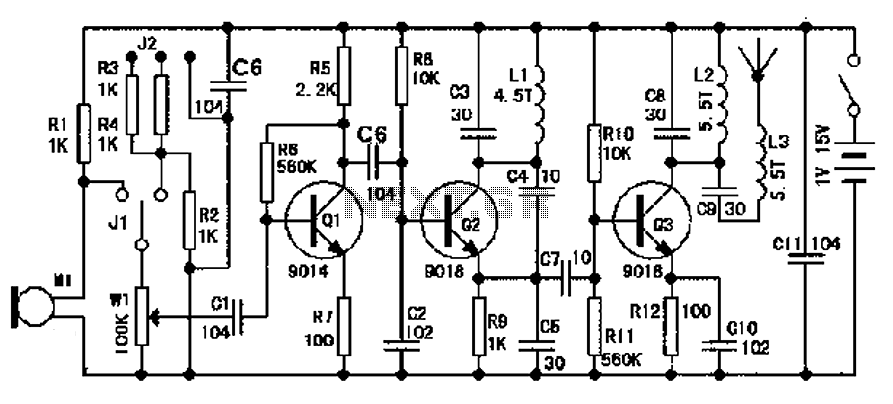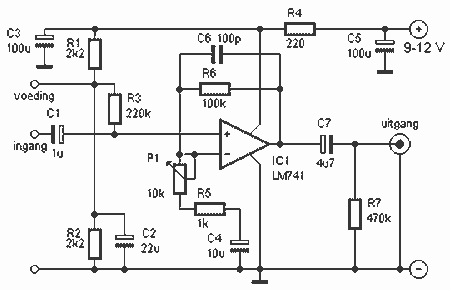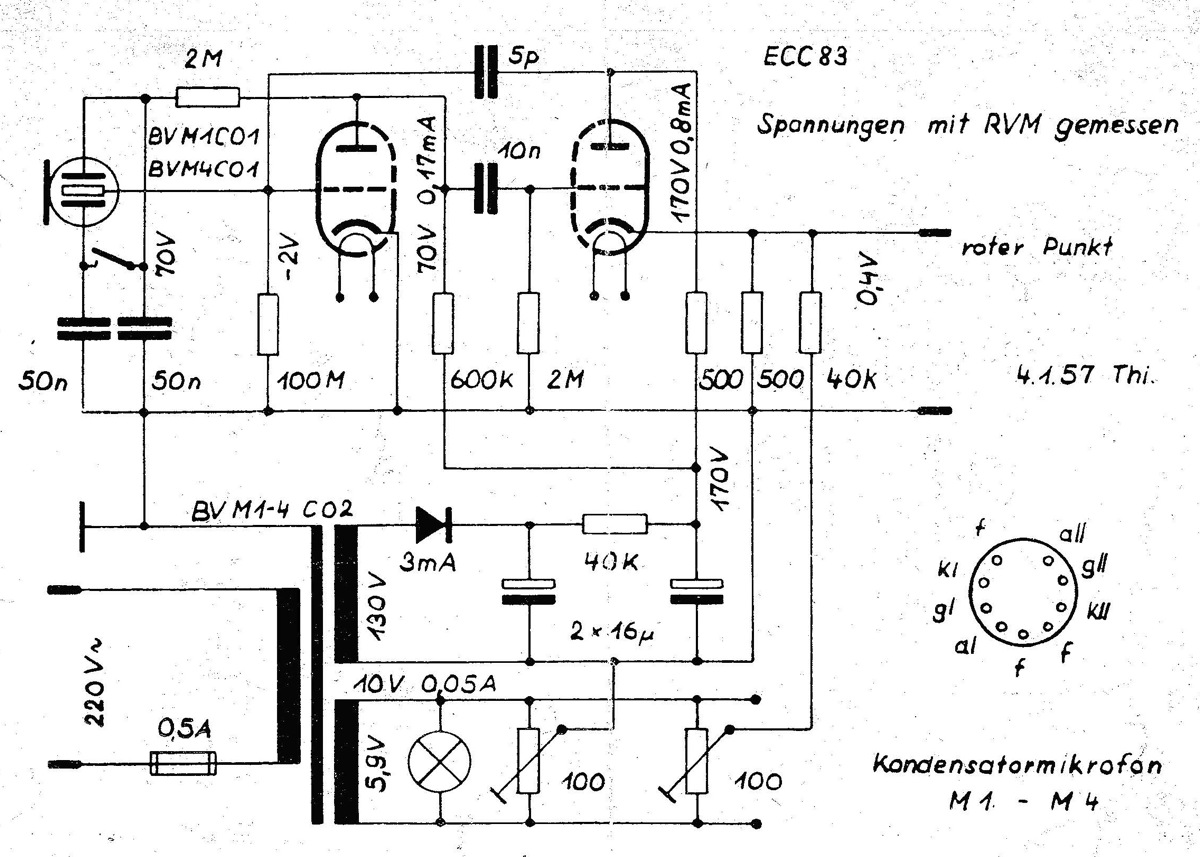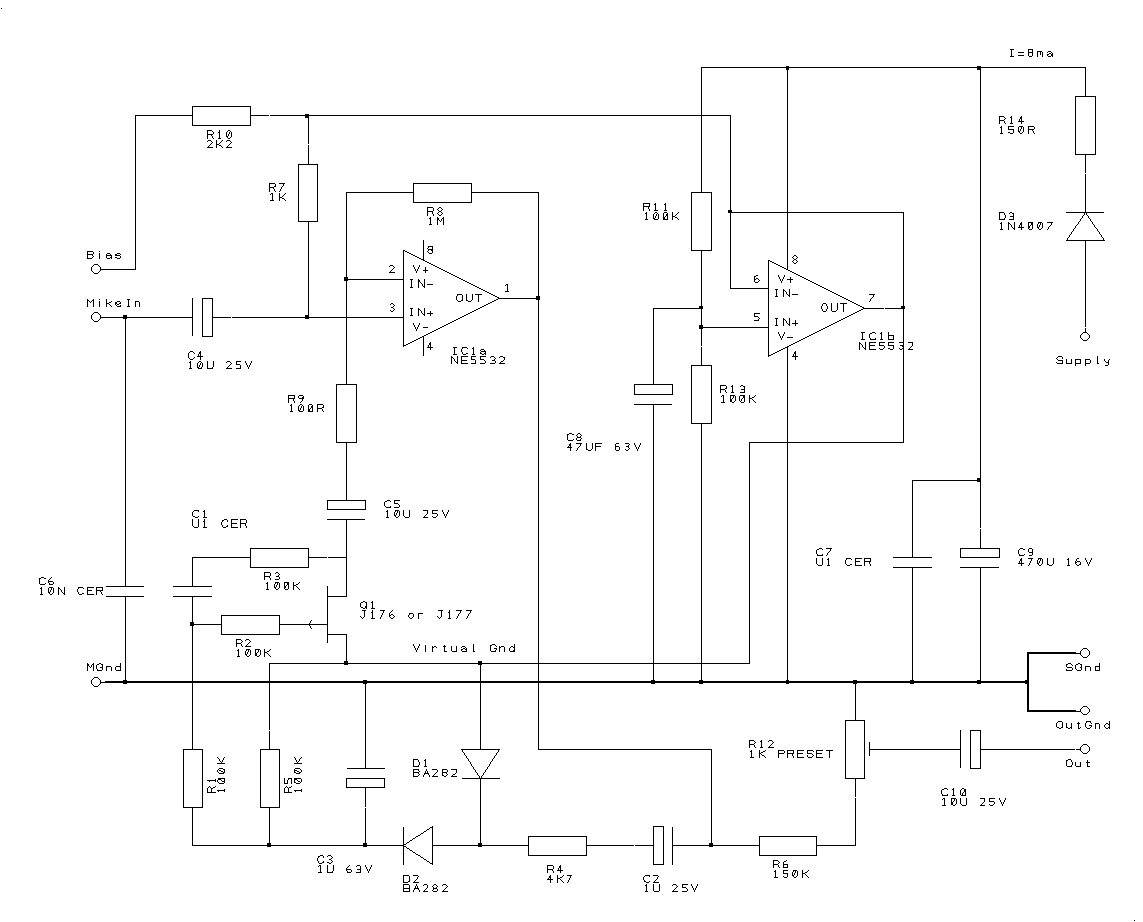
FM Wireless Microphone
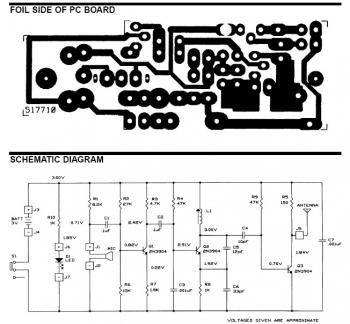
The frequency range for the FM broadcast band is 90 MHz (megahertz, or 90 million cycles per second). An FM microphone utilizes a variable tuned circuit, allowing it to be adjusted to a quiet frequency within the local FM broadcast band for optimal reception. When the microphone element detects sound, it converts the audio signal into a change in current through resistor R1 (as indicated in the schematic diagram). This electrical change is amplified and subsequently frequency modulates the transmitter. The operational range of the FM microphone is approximately 100 feet, contingent upon the antenna's efficiency (whether it is properly tuned) and the FM radio receiver's quality. The short wave AM transmitter circuit design is straightforward and can be constructed with a minimal number of electronic components. A notable feature of this transmitter is its independence from an LC (inductor-capacitor) tuned circuit, operating instead at a fixed frequency of 12 MHz. This mini FM transmitter, designed by Tony van Roon, is powered by two transistors, is simple to assemble, and can be received on any standard FM radio. Its transmission range is approximately 1/4 mile (400 meters), depending on line-of-sight and potential obstructions. Additionally, a wireless car alarm system can be constructed using two circuit modules: a transmitter and a receiver, operating on FM radio waves. This system is suitable for vehicles with a 6-12 VDC power supply, with the option to use a voltage stabilizer if necessary. Another design is a powerful three-stage, 9V FM transmitter (Tx) with a range of up to 1 kilometer in open conditions, utilizing an RF transistor in the output stage and two BC547 transistors in the initial stages. The transmission distance is highly dependent on the operating environment (indoor or outdoor). There is also a low-cost, easy-to-build low-powered FM transmitter with a claimed range of about 300 feet at a 9V supply, which can extend to approximately 400 feet when powered at 12V. It is essential to note that this transmitter should not be used for unauthorized transmissions. Furthermore, there exists an FM transmitter circuit that incorporates four radio frequency stages: a VHF oscillator based on transistor BF494 (T1), a preamplifier using transistor BF200 (T2), a driver utilizing transistor 2N2219 (T3), and a power amplifier built around transistor 2N3866 (T4). A condenser microphone is connected at the input.
The FM broadcast band operates within the frequency range of 88 to 108 MHz, allowing for a variety of audio transmissions. The FM microphone's variable tuned circuit is essential in ensuring that the microphone can effectively select a frequency with minimal interference, thereby enhancing audio clarity. The conversion of sound into an electrical signal through the microphone element is a critical process that involves transducing mechanical vibrations into electrical changes, which are then processed through the resistor R1. This initial signal undergoes amplification, ensuring that even faint audio signals can be transmitted effectively.
The mini FM transmitter, while operating at a fixed frequency of 12 MHz, simplifies the design and reduces the complexity typically associated with tunable circuits. The use of only two transistors makes it an economical option for hobbyists and those new to electronics. The transmission range of 1/4 mile indicates its potential for various applications, including personal broadcasting and educational demonstrations.
The wireless car alarm system exemplifies practical applications of FM transmission technology. The use of FM radio waves for communication between the transmitter and receiver modules enables reliable operation over a specified range. The voltage requirements of 6-12 VDC ensure compatibility with most vehicle electrical systems, while the inclusion of a voltage stabilizer enhances the circuit's robustness against voltage fluctuations.
The three-stage FM transmitter, capable of reaching distances of up to 1 kilometer, showcases the potential for more powerful and expansive transmission applications. The choice of transistors, such as the RF transistor and BC547, is critical in determining the performance characteristics of the transmitter stages, including gain and frequency response.
Finally, the multi-stage FM transmitter circuit design illustrates the versatility of FM technology, incorporating various transistors to achieve specific functions such as oscillation, amplification, and transmission. The integration of a condenser microphone at the input stage facilitates direct audio input, making the circuit suitable for a variety of audio transmission applications. Overall, these designs reflect the principles of FM transmission and the potential for innovative applications in wireless communication.The range of frequencies for the FM broadcast band is 90MHz (MHz = Megahertz or 90 million cycles per second). Because the FM microphone has a variable tuned circuit, it can be tuned to a quiet spot on your local FM broadcast band for the best reception.
When the small microphone element is struck by sound, it converts the audio to a change in cu rrent through resistor R1 (see schematic diagram). This electrical change is amplified and eventually frequency modulates the transmitter. The transmission range of the FM microphone is approximately 100 feet, depending on the efficiency of the antenna (properly tuned or not) and the quality of the FM radio receiver. Here the short wave AM Transmitter circuit design diagram. The circuit is quite simple and easy to build since it applies only a few electronic components. The primary feature of this transmitter is that it really is absolutely free from the LC (inductor, capacitor) tuned circuit and runs using a fixed frequency of 12 MHz.
This is a mini FM transmitter built and powered using 2 transistors, designed by Tony van Roon. This small transmitter is simple to build and its transmissions could be picked up on any common FM radio. It possesses a range of approximately 1/4-mile (400 meters) or even more, depending on the line-of-sight, obstructions by big.
This circuit is a wireless car alarm system that is built using two circuit modules, namely modules of transmitter and receiver modules. This circuit works on FM radio waves. Car alarms can be used on vehicles that have a 6-12VDC power supply. You can use the voltage stabilizer if your car power supply is too. This circuit is a powerful three stage, 9V FM transmitter (Tx) with a range of up to 1 kilometer in the open.
It uses an RF transistor in its output stage and two BC547`s for the first two stages. Distance of trans-mission is critically dependent on the operating Conditions (in a building or out on. This is a low cost and easy build low powered FM transmitter. The range of the FM transmitter claimed about 300 feets when running at 9V supply. And the range claimed to be increased become about 400 feet when running it at 12V supply. Take a note that this transmitter should not be used as. This is the FM transmitter circuit which apply 4 radio frequency stages, that are a VHF oscillator designed around transistor BF494 (T1), a preamplifier designed around transistor BF200 (T2), a driver designed around transistor 2N2219 (T3) and also a power amplifier designed around transistor 2N3866 (T4).
A condenser microphone is wired at the input of. 🔗 External reference
The FM broadcast band operates within the frequency range of 88 to 108 MHz, allowing for a variety of audio transmissions. The FM microphone's variable tuned circuit is essential in ensuring that the microphone can effectively select a frequency with minimal interference, thereby enhancing audio clarity. The conversion of sound into an electrical signal through the microphone element is a critical process that involves transducing mechanical vibrations into electrical changes, which are then processed through the resistor R1. This initial signal undergoes amplification, ensuring that even faint audio signals can be transmitted effectively.
The mini FM transmitter, while operating at a fixed frequency of 12 MHz, simplifies the design and reduces the complexity typically associated with tunable circuits. The use of only two transistors makes it an economical option for hobbyists and those new to electronics. The transmission range of 1/4 mile indicates its potential for various applications, including personal broadcasting and educational demonstrations.
The wireless car alarm system exemplifies practical applications of FM transmission technology. The use of FM radio waves for communication between the transmitter and receiver modules enables reliable operation over a specified range. The voltage requirements of 6-12 VDC ensure compatibility with most vehicle electrical systems, while the inclusion of a voltage stabilizer enhances the circuit's robustness against voltage fluctuations.
The three-stage FM transmitter, capable of reaching distances of up to 1 kilometer, showcases the potential for more powerful and expansive transmission applications. The choice of transistors, such as the RF transistor and BC547, is critical in determining the performance characteristics of the transmitter stages, including gain and frequency response.
Finally, the multi-stage FM transmitter circuit design illustrates the versatility of FM technology, incorporating various transistors to achieve specific functions such as oscillation, amplification, and transmission. The integration of a condenser microphone at the input stage facilitates direct audio input, making the circuit suitable for a variety of audio transmission applications. Overall, these designs reflect the principles of FM transmission and the potential for innovative applications in wireless communication.The range of frequencies for the FM broadcast band is 90MHz (MHz = Megahertz or 90 million cycles per second). Because the FM microphone has a variable tuned circuit, it can be tuned to a quiet spot on your local FM broadcast band for the best reception.
When the small microphone element is struck by sound, it converts the audio to a change in cu rrent through resistor R1 (see schematic diagram). This electrical change is amplified and eventually frequency modulates the transmitter. The transmission range of the FM microphone is approximately 100 feet, depending on the efficiency of the antenna (properly tuned or not) and the quality of the FM radio receiver. Here the short wave AM Transmitter circuit design diagram. The circuit is quite simple and easy to build since it applies only a few electronic components. The primary feature of this transmitter is that it really is absolutely free from the LC (inductor, capacitor) tuned circuit and runs using a fixed frequency of 12 MHz.
This is a mini FM transmitter built and powered using 2 transistors, designed by Tony van Roon. This small transmitter is simple to build and its transmissions could be picked up on any common FM radio. It possesses a range of approximately 1/4-mile (400 meters) or even more, depending on the line-of-sight, obstructions by big.
This circuit is a wireless car alarm system that is built using two circuit modules, namely modules of transmitter and receiver modules. This circuit works on FM radio waves. Car alarms can be used on vehicles that have a 6-12VDC power supply. You can use the voltage stabilizer if your car power supply is too. This circuit is a powerful three stage, 9V FM transmitter (Tx) with a range of up to 1 kilometer in the open.
It uses an RF transistor in its output stage and two BC547`s for the first two stages. Distance of trans-mission is critically dependent on the operating Conditions (in a building or out on. This is a low cost and easy build low powered FM transmitter. The range of the FM transmitter claimed about 300 feets when running at 9V supply. And the range claimed to be increased become about 400 feet when running it at 12V supply. Take a note that this transmitter should not be used as. This is the FM transmitter circuit which apply 4 radio frequency stages, that are a VHF oscillator designed around transistor BF494 (T1), a preamplifier designed around transistor BF200 (T2), a driver designed around transistor 2N2219 (T3) and also a power amplifier designed around transistor 2N3866 (T4).
A condenser microphone is wired at the input of. 🔗 External reference
